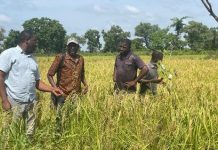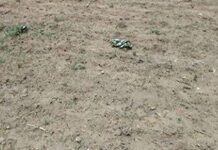LINKING AGRICULTURE TO PROCESSING
This column is devoted to monitoring and reporting on issues related to food security in the Gambia as well as the interventions of Government and Non-governmental Organizations.
As from the last edition Farmers’ Eye has been focusing on the Agricultural Programmes geared towards food security which will feature comments by farmers on the impact of the programmes on their lives.
In part one, it was indicated that since 2000, a number of programmes aimed at increasing food security have been initiated and are at various stages of implementation. In addition, government harmonized its sector policies and programmes with global and regional initiatives such as the Millennium Development Goals (MDGs), the Comprehensive Africa Agriculture Development Programme (CAADP) of the New Partnership for Africa’s Development (NEPAD), and the Common Agriculture Policy (ECOWAP) of the Economic Community of West African States {ECOWAS).
Part One showed that during the decade, the priorities of the sector have been to achieve sustainable food security at the household and national levels and toward this end, there were calls for the Agriculture and Natural Resources sector to be commercialized, while at the same time linking small and medium producers to improved technologies and markets, and increasing the competitiveness of the sector by reducing the domestic production costs, and improving quality.
In this edition, we shall deal with Development of Agricultural Chains and Market Promotion as contained in the Gambia National Agricultural Investment Program blueprint.
DEVELOPMENT OF AGRICULTURAL CHAINS AND MARKET PROMOTION
The Gambia produces a wide range of agricultural products which can be processed for both domestic consumption and export marketing.
However, the agro-industry in the Gambia is limited because the vast majority of the perishable farm produce have virtually no value addition after their production.
These products are not processed, but are consumed in their primary condition. As a result, these perishable products are often wasted, or sold at a give away price.
Agricultural chains can make significant contributions to the ANR sector in the Gambia by helping to transform it from a traditional subsistence form to a commercial and modern one. This is because agro-industries and related activities help improve the efficiency of value chains of high value commodities for which the country has comparative advantages in producing, provide sustainable sources of income and employment, and can help the country fight cheap food imports.
Like the food production sub-sector, the agri-business and agro-processing sub-sectors are characterized by many smallholders using low output technologies, and labour intensive systems, resulting in poor quality products and low income. These sub-sectors also face many constraints such as poor feeder road network, inconsistent power supply, and weak local demand.
Additional challenges include a poor communication network, undeveloped food retailing, and lack of a temperature-controlled distribution chain.
Given the relatively small size of the Gambian market, the country has to tap regional and international markets if the sector is to achieve significant growth.
Against this background, the National Agricultural Investment Program includes a sub-program on the development of agricultural chains and market promotion.
In line with the thematic areas of the Regional Agricultural Investment Program for West Africa, this sub-program has three components namely: the development of food processing chains, strengthening of regional operator support services, and the promotion of intra-regional and extra-regional trade.
DEVELOPMENT OF FOOD PROCESSING CHAINS
The food processing sub-sector is important because of its direct link with agriculture, its contribution to food security for the nation, and its potential as foreign exchange saver through efficient import substitution.
However, there is little evidence of a coordinated, integrated, national strategy for agro-food industry in The Gambia.
This is a major constraint to efficiency of the various public and private organizations working in or on behalf of the industry.
The Gambian farmers have access to little or no processing and preservation technology, particularly female horticultural producers. They still use the traditional preservation techniques such as sun-drying, salting, fermenting, smoking, roasting and grinding.
Besides, the sector mainly comprises grain-milling and edible oil extraction at the community-based level.
The vast majority of fruits and vegetables have virtually no value added to them. Fruits and vegetables are among the readily perishable commodities, which form an important part of The Gambia’s food supplies. The storage of fruit and vegetables in the rural areas is one out of several post-harvest constraints that farmers are experiencing each year.
The food processing activity in the Gambia is significantly constrained by inadequate quality of raw material, high post-harvest wastage levels (30-
50 percent), high production costs, and low capacity utilization.
Additional constraints include the absence of cold-chain, non-availability of. packaging material, limited access to credit, inadequate support services, absence of regulatory framework, unreliable supply of factor inputs, undeveloped consumer taste for processed foods, and a weak marketing and distribution system.
The government will address the sector-wide constraints through a strategy of public and private sector partnership. Toward this end, the private sector is expected to assume a lead role in the provision of enterprise investment resources and entrepreneurial management to be facilitated by public sector catalytic roles.
Has this program been achieved? What is the situation of the farmers in terms of poverty and food insecurity?
See Part Three
]]>
food security in the Gambia as well as the interventions of Government and Non-governmental Organizations.
As from the last edition Farmers’ Eye has been focusing on the Agricultural Programmes geared towards food security which will feature comments by farmers on the impact of the programmes on their lives.
In part one, it was indicated that since 2000, a number of programmes aimed at increasing food security have been initiated and are at various stages of implementation. In addition, government harmonized its sector policies and programmes with global and regional initiatives such as the Millennium Development Goals (MDGs), the Comprehensive Africa Agriculture Development Programme (CAADP) of the New Partnership for Africa’s Development (NEPAD), and the Common Agriculture Policy (ECOWAP) of the Economic Community of West African States {ECOWAS).
Part One showed that during the decade, the priorities of the sector have been to achieve sustainable food security at the household and national levels and toward this end, there were calls for the Agriculture and Natural Resources sector to be commercialized, while at the same time linking small and medium producers to improved technologies and markets, and increasing the competitiveness of the sector by reducing the domestic production costs, and improving quality.
In this edition, we shall deal with Development of Agricultural Chains and Market Promotion as contained in the Gambia National Agricultural Investment Program blueprint.
DEVELOPMENT OF AGRICULTURAL CHAINS AND MARKET PROMOTION
The Gambia produces a wide range of agricultural products which can be processed for both domestic consumption and export marketing.
However, the agro-industry in the Gambia is limited because the vast majority of the perishable farm produce have virtually no value addition after their production.
These products are not processed, but are consumed in their primary condition. As a result, these perishable products are often wasted, or sold at a give away price.
Agricultural chains can make significant contributions to the ANR sector in the Gambia by helping to transform it from a traditional subsistence form to a commercial and modern one. This is because agro-industries and related activities help improve the efficiency of value chains of high value commodities for which the country has comparative advantages in producing, provide sustainable sources of income and employment, and can help the country fight cheap food imports.
Like the food production sub-sector, the agri-business and agro-processing sub-sectors are characterized by many smallholders using low output technologies, and labour intensive systems, resulting in poor quality products and low income. These sub-sectors also face many constraints such as poor feeder road network, inconsistent power supply, and weak local demand.
Additional challenges include a poor communication network, undeveloped food retailing, and lack of a temperature-controlled distribution chain.
Given the relatively small size of the Gambian market, the country has to tap regional and international markets if the sector is to achieve significant growth.
Against this background, the National Agricultural Investment Program includes a sub-program on the development of agricultural chains and market promotion.
In line with the thematic areas of the Regional Agricultural Investment Program for West Africa, this sub-program has three components namely: the development of food processing chains, strengthening of regional operator support services, and the promotion of intra-regional and extra-regional trade.
DEVELOPMENT OF FOOD PROCESSING CHAINS
The food processing sub-sector is important because of its direct link with agriculture, its contribution to food security for the nation, and its potential as foreign exchange saver through efficient import substitution.
However, there is little evidence of a coordinated, integrated, national strategy for agro-food industry in The Gambia.
This is a major constraint to efficiency of the various public and private organizations working in or on behalf of the industry.
The Gambian farmers have access to little or no processing and preservation technology, particularly female horticultural producers. They still use the traditional preservation techniques such as sun-drying, salting, fermenting, smoking, roasting and grinding.
Besides, the sector mainly comprises grain-milling and edible oil extraction at the community-based level.
The vast majority of fruits and vegetables have virtually no value added to them. Fruits and vegetables are among the readily perishable commodities, which form an important part of The Gambia’s food supplies. The storage of fruit and vegetables in the rural areas is one out of several post-harvest constraints that farmers are experiencing each year.
The food processing activity in the Gambia is significantly constrained by inadequate quality of raw material, high post-harvest wastage levels (30-
50 percent), high production costs, and low capacity utilization.
Additional constraints include the absence of cold-chain, non-availability of. packaging material, limited access to credit, inadequate support services, absence of regulatory framework, unreliable supply of factor inputs, undeveloped consumer taste for processed foods, and a weak marketing and distribution system.
The government will address the sector-wide constraints through a strategy of public and private sector partnership. Toward this end, the private sector is expected to assume a lead role in the provision of enterprise investment resources and entrepreneurial management to be facilitated by public sector catalytic roles.
Has this program been achieved? What is the situation of the farmers in terms of poverty and food insecurity?
See Part Three
]]>


















